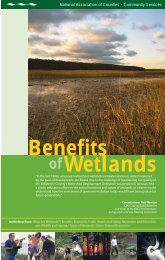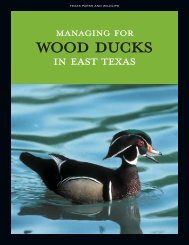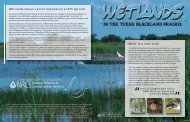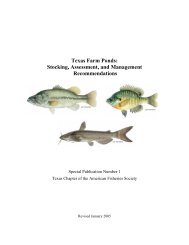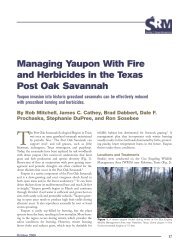Angler's Guide to Fish Diseases and Parasites - University of Georgia
Angler's Guide to Fish Diseases and Parasites - University of Georgia
Angler's Guide to Fish Diseases and Parasites - University of Georgia
You also want an ePaper? Increase the reach of your titles
YUMPU automatically turns print PDFs into web optimized ePapers that Google loves.
Cooperative Extension Service / The <strong>University</strong> <strong>of</strong> <strong>Georgia</strong><br />
College <strong>of</strong> Agricultural <strong>and</strong> Environmental Sciences / Athens<br />
Angler’s <strong>Guide</strong> <strong>to</strong> <strong>Fish</strong><br />
<strong>Diseases</strong> <strong>and</strong> <strong>Parasites</strong><br />
Material adapted from “What’s Bugging That <strong>Fish</strong> -- An Angler’s <strong>Guide</strong> <strong>to</strong> <strong>Fish</strong> <strong>Diseases</strong> <strong>and</strong> <strong>Parasites</strong>.” Nebraska Game <strong>and</strong> Park Commission.<br />
The Cooperative Extension Service, The <strong>University</strong> <strong>of</strong> <strong>Georgia</strong> College <strong>of</strong> Agricultural <strong>and</strong> Environmental Sciences <strong>of</strong>fers educational programs,<br />
assistance <strong>and</strong> materials <strong>to</strong> all people without regard <strong>to</strong> race, color, natural origin, age, sex, or h<strong>and</strong>icap status.<br />
AN EQUAL OPPORTUNITY EMPLOYER<br />
Circular 772 F&A-1 Reprinted November, 1991<br />
Issued in furtherance <strong>of</strong> Cooperative Extension work, Acts <strong>of</strong> May 8, <strong>and</strong> June 30, 1914, The <strong>University</strong> <strong>of</strong> <strong>Georgia</strong> College <strong>of</strong> Agricultural <strong>and</strong><br />
Environmental Sciences <strong>and</strong> the U.S. Department <strong>of</strong> Agriculture cooperating.
Angler’s <strong>Guide</strong> <strong>to</strong> <strong>Fish</strong> <strong>Diseases</strong> <strong>and</strong> <strong>Parasites</strong><br />
Prepared by George W. Lewis<br />
Aquaculture <strong>and</strong> <strong>Fish</strong>eries Specialist<br />
Occasionally anglers catch fish that show signs <strong>of</strong> infection or parasitism. Is the fish safe <strong>to</strong> eat<br />
The usual <strong>and</strong> safest response <strong>to</strong> this question is, “When in doubt - don’t.’’ However, very few<br />
fish diseases can be transferred <strong>to</strong> humans. Almost all fish are safe <strong>to</strong> eat when thoroughly<br />
cooked, smoked or frozen.<br />
<strong>Fish</strong> are a valuable resource in <strong>Georgia</strong>. Not only do they provide important recreation, but they<br />
are also a valuable supplement <strong>to</strong> the family food budget. The anticipation <strong>of</strong> any fisherman,<br />
whether he be a young boy with a cane pole <strong>and</strong> a can <strong>of</strong> worms or an ‘’old pro,” is a quality fish<br />
for the table. It is the unwritten law <strong>of</strong> any true sportsman <strong>to</strong> utilize the fish he catches. The<br />
purpose <strong>of</strong> this publication is <strong>to</strong> help you, the angler, determine if the fish you’ve caught is worthy<br />
<strong>of</strong> your skillet. Remember, a sick fish will not take the hook.<br />
For convenience, we have listed groups <strong>of</strong> parasites diseases <strong>and</strong> other causes <strong>of</strong> abnormalities<br />
sometimes seen in the fisherman’s catch.<br />
1. Viruses <strong>and</strong> Bacteria: These microorganisms cannot be seen with the naked eye. They cause<br />
many diseases in fish. Symp<strong>to</strong>ms include swollen, fluid-filled body cavity, bulging eyes, bloody<br />
fins, bloody spots on the skin or base <strong>of</strong> scales, sores, <strong>and</strong> lesions, etc.<br />
2. Fungi: Fungi are small, str<strong>and</strong>-like parasites. They normally do not infect healthy fish. They<br />
usually grow on dead tissue or infected wounds. Most <strong>of</strong> the fungi on fish have a patchy,<br />
gray-white, cot<strong>to</strong>n-like appearance.
3. Pro<strong>to</strong>zoa: These are microscopic, single-cell animals. They can be found on the gills, body<br />
surface or imbedded in the flesh. There are many different pro<strong>to</strong>zoans, <strong>and</strong> they cause a variety <strong>of</strong><br />
fish diseases. <strong>Fish</strong>erman usually observe the damage they cause but rarely see the microorganism<br />
without the aid <strong>of</strong> a microscope.<br />
4. Trema<strong>to</strong>de or Fluke: There are two groups <strong>of</strong> flukes. Monogenetic flukes live on the external<br />
body surface <strong>and</strong> multiply on the same host. Digenetic flukes are internal fish parasites <strong>and</strong><br />
require two or more hosts <strong>to</strong> complete their life cycle. Other hosts may include snails, clams,<br />
birds or other fish - but not man. Trema<strong>to</strong>des can be found in cysts in the flesh or other internal<br />
organs. They also can live in the eye, blood, gills <strong>and</strong> other parts <strong>of</strong> the fish. Trema<strong>to</strong>des are<br />
rarely observed by fisherman.<br />
5. Ces<strong>to</strong>de or Tapeworm: These parasites are commonly observed by fishermen when cleaning<br />
their catch. Larval tapeworms form cysts on or in the internal organs or in the body cavity. Adults<br />
are white <strong>and</strong> worm-like <strong>and</strong> are found in the intestines.<br />
6. Acanthocephalan or Spiny-Headed Worm: These parasites are rarely seen by fishermen. They<br />
live in the intestines <strong>of</strong> fish.
7. Nema<strong>to</strong>de or Round Worm: Nema<strong>to</strong>des are very common parasites <strong>of</strong> ski. The larvae may be<br />
found in cysts or coiled in or on the internal organs. Adults are usually found in the intestines.<br />
Some are found coiled under the skin.<br />
8. Leeches: These parasites are external, blood-feeding animals. They leave circular wounds on<br />
the fish.<br />
9. Copepods: These small crustaceans can be embedded in flesh, gills or mouth. Some move<br />
freely over the body surface.<br />
10. Tumors: As on other animals, tumors occasionally occur on fish.<br />
11. Physical Injury: Preda<strong>to</strong>rs, such as birds <strong>and</strong> other fish, can cause wounds <strong>and</strong> other<br />
malformities.
OBSERVED EXTERNALLY<br />
Visual Signs<br />
Lesions, sores, hemorrhages, fish pop-eyed,<br />
blood under scales, or loss <strong>of</strong> scales.<br />
Comments<br />
Various species <strong>of</strong> bacteria can infect fish.<br />
Symp<strong>to</strong>ms vary depending on bacteria <strong>and</strong><br />
fish species. Bacterial infections are usually<br />
the result <strong>of</strong> a stress on the fish or infection<br />
<strong>of</strong> a wound. An infected fish is edible. Trim<br />
away infected flesh.<br />
Cot<strong>to</strong>n-like, white-tan-gray fuzzy growth on<br />
body or fins.<br />
Fungus infection <strong>of</strong> wound or lesion. An<br />
infected fish is edible. Trim away infected<br />
flesh.<br />
Small, pinhead-size white spots on the skin<br />
<strong>of</strong> catfish <strong>and</strong> sometimes excessive mucus<br />
(slime) production.<br />
Ich (Ichthyophthirius) is a common pro<strong>to</strong>zoan<br />
parasite <strong>of</strong> catfish. It occurs on the<br />
skin <strong>and</strong> gills <strong>of</strong> catfish <strong>and</strong> some other fish<br />
species. An infected fish is edible. Clean<br />
<strong>and</strong> prepare as usual.<br />
Small, black-<strong>to</strong>-purple spots under the skin<br />
or in the flesh <strong>of</strong> scale fish.<br />
Black Spot is one <strong>of</strong> the more frequent<br />
parasites observed by fishermen. It is caused<br />
by larval flukes encysting under the skin or<br />
in the flesh. An infected fish is edible. Clean<br />
<strong>and</strong> prepare as usual.<br />
Eye opaque or deformed.<br />
Eye Flukes live in the fluid <strong>of</strong> the eye.<br />
Although they cannot be seen by the fishermen,<br />
they eventually cause blindness in the<br />
fish. An infected fish is edible. Clean <strong>and</strong><br />
prepare as usual.
Gills swollen <strong>and</strong> pink<br />
There are a number <strong>of</strong> gill parasites infecting<br />
fish. They are microscopic <strong>and</strong> only the<br />
damage they cause is observed by the fisherman.<br />
Some <strong>of</strong> these parasites are gill flukes<br />
<strong>and</strong> a number <strong>of</strong> Pro<strong>to</strong>zoan species. Chemicals<br />
in the water can also irritate the gills <strong>and</strong><br />
present the same symp<strong>to</strong>ms. Unless chemicals<br />
are suspected, the fish is edible. Clean<br />
<strong>and</strong> prepare as usual.<br />
Thread-like red worm extending from the<br />
anus.<br />
Roundworms can be found throughout the<br />
intestines. They sometimes can be seen<br />
extending from the anus. An infected fish is<br />
edible. Clean <strong>and</strong> prepare as usual.<br />
Worm-like animal attached <strong>to</strong> the body,<br />
head, fins, or gills.<br />
Leeches are blood-sucking animals that leave<br />
a circular wound after they have dropped <strong>of</strong>f<br />
the fish. An infected fish is edible. Clean <strong>and</strong><br />
prepare as usual.<br />
Small, red pustual with red thread-like body<br />
protruding from wound at the base <strong>of</strong> scale<br />
or on or near the base <strong>of</strong> fins.<br />
Anchor Worm is an appropriate name for this<br />
parasitic copepod. It buries its anchorshaped<br />
head in<strong>to</strong> the flesh <strong>and</strong> allows its<br />
body <strong>to</strong> hang free <strong>of</strong> the wound. An infected<br />
fish is edible. Clean <strong>and</strong> prepare as usual.<br />
Small, bloody areas at the base or under the<br />
scales <strong>of</strong> a fish.<br />
<strong>Fish</strong> Louse are microscopic copepods rarely<br />
seen by fishermen. They feed on the blood<br />
by piercing. the skin. The bites can become<br />
infected. An infected fish is edible. Clean<br />
<strong>and</strong> prepare as usual.
OBSERVED INTERNALLY<br />
White worms in the intestine.<br />
Adult flukes, tapeworms, roundworms or<br />
spiny-headed worms are commonly observed<br />
in the intestines <strong>of</strong> fish. The fish is edible.<br />
Clean <strong>and</strong> prepare as usual.<br />
Large, white flat worm in body cavity.<br />
Tapeworm found in the body cavity <strong>of</strong> carp<br />
suckers, minnows <strong>and</strong> some other fish. The<br />
fish is edible. Clean <strong>and</strong> prepare as usual.<br />
Worm encysted on internal organs coiled like<br />
a watch spring.<br />
Larval Roundworm. The fish is edible.<br />
Clean <strong>and</strong> prepare as usual.<br />
Small cysts on internal organs.<br />
Larval Flukes. The fish is edible. Clean <strong>and</strong><br />
prepare as usual.<br />
Small, white thread-like worms on or in<br />
internal organs.<br />
Larval Tapeworms. Often found in the<br />
ovaries. The fish is edible. Clean <strong>and</strong><br />
prepare as usual.<br />
Small, white-<strong>to</strong>-orange worm in body cavity<br />
or attached <strong>to</strong> intestines.<br />
Spiny-headed worm usually lives inside<br />
intestines. Sometimes they are found lying in<br />
the body cavity with their heads buried in the<br />
intestines. The fish is edible. Clean <strong>and</strong><br />
prepare as usual.




